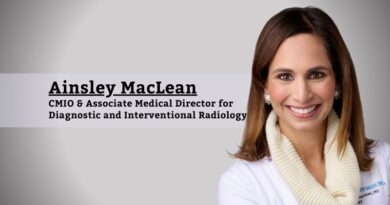Transitioning to Patient-owned Data
By Dustin Hufford, SVP & CIO, Cooper University Health Care
Healthcare’s primary problem is not the lack of data, but the lack of fidelity and usability of the available data. The challenge is collating, interpreting, and distilling data to a usable state and getting those data to the right person, at the right time. Additionally, healthcare data is unwieldy and fractured, continuing to fracture exponentially as more care channels and options emerge. New channels generate new data silos that make safe, effective care difficult. Compounding this issue, costs of health insurance, care delivery, and medications continue to rise, placing adequate healthcare out of reach for many. As a result, the quality of care across the US continues to lag significantly behind other countries.
Patients are the reason healthcare exists, and yet, they are rarely centered in their information or care.
Also, the US healthcare is experiencing an unprecedented period of change, brought on by industry pressures, which makes an already complex system more cumbersome and perilous.
These pressures include:
- Dramatic shifts in consumer expectations: Younger consumers are not satisfied with traditional healthcare, and consumers of all age groups are more willing than ever to try non-traditional services. Millennials and gen Z, who make up 42% of the population and 21% of healthcare services, expect convenience, affordability, transparency, and quality and are redefining how they engage in every stage of their care.
- Fragmentation: The delivery of care through established service paths (e.g., doctors, clinics, and medical centers) must now compete with non-traditional service paths that represent emerging types of service delivery (e.g., walk-in or retail clinics, outpatient surgery hospitals, virtual health, on-demand services, in-home services, or digital therapeutics).
- Increased regulatory pressures: The burden of new and existing laws regulating healthcare—such as HITECH, HIPAA, ACA, FDASIA, and MACRA/MIPS—affects providers by increasing their administrative load and by adding or increasing penalties for services that do not meet a set of prescribed quality, interoperability, and performance criteria. These burdens slow the delivery of care and reduce patient interface time with doctors and their clinical staff, alongside a host of other factors that can negatively impact care delivery, patient outcomes, and provider reimbursement.
- Hyper-specialization as the knowledge about diseases accelerates: Medical research continues to reveal the complexity behind disease causes and treatments. As research unravels the genome, microbiome, and proteome, referred to as multiomics, to understand their role in health and wellness, physicians become more specialized to turn discoveries into better outcomes for patients.
Data is duplicated and conflicting due to issues with standards
Because most health record systems do not consolidate information, numerous patient and provider-reported health records result in duplication, retention of outdated information, and leave room for error. Also, payer data often inaccurately reflects patient care and services provided due to the complicated nature of billing practices. Often, to ease workflow, patient services are billed based on a short list of memorized codes or the first code to populate a search, resulting in loss of fidelity. Therefore, providers don’t uniformly have access to accurate reference records which creates an overwhelming burden on providers trying to find the information needed to make recommendations.
Projects to enable interoperability are costly and time-consuming
Traditional data transformation and sharing methods are complex and deduplicating of the data with any precision is time-consuming and risky. Important changes in a patient’s record can take weeks or even months to emerge, as the data integration does not happen in near real time. There are existing methods of sharing more cleanly within like EMRs, but even in that method, there are issues reconciling data due to the differences in system setup (x field in system A is blood pressure, whereas it’s y field in system B).
The patient is never in control of their data
Patients are the reason healthcare exists, and yet, they are rarely centered in their information or care. They have little control of their data and, in most cases, have no concept of how the data is used and where it’s shared. Also, all too often, patient-provided information fails to be integrated with the patient’s record thereby ignoring critical pieces of information. By ignoring the patient as a vital part of healthcare and its interoperability, data sharing and cleansing become complex and diminishes the capabilities of healthcare providers to make data-based diagnoses and treatment decisions.
What can and should be done?
We should strive for a single, golden record for every person on Earth that is updated in real-time as changes happen and allows for notification of significant events to be delivered to the right person at the right time. And that record should be owned by the individual, not the system.
There have been many barriers to this in the past, but the most significant challenge has been to uniquely identify each person and all of the entities and assets they interact with.
Luckily, technologies and tools emerging on the market now can systematically address these issues through AI and machine learning. Tasks considered nearly impossible, like merging 20 medical records and distilling the information down to a single record, can now be done at scale, with the patient owning the overall outcome.
One emerging company consolidates health and wellness data into a single, standardized record under secure control of the patient that facilitates seamless data exchange amongst healthcare and life science constituents. The technology leverages syntactic, structural, and semantic interoperability techniques in addition to patient-level interventions when AI cannot resolve the data cleansing automatically.
In addition to focusing on rich medical data, this company continuously fills gaps with real-time, real-world data from multiple sources (e.g., wearable and medical devices), in conjunction with social determinants of health (SDOH) and patient-reported information.
How do we get there?
While companies like this are working to solve this problem, there are cultural barriers in the US that need to be overcome. To truly achieve patient-owned interoperability, data hoarding and profiteering concepts need to be addressed. Healthcare needs to be democratized for a more equitable landscape. Platforms that democratize health information shift people from passive to active participants within their own health outcomes. After all, it is ultimately the patient that bears the burden of adverse health outcomes, not the providers.



